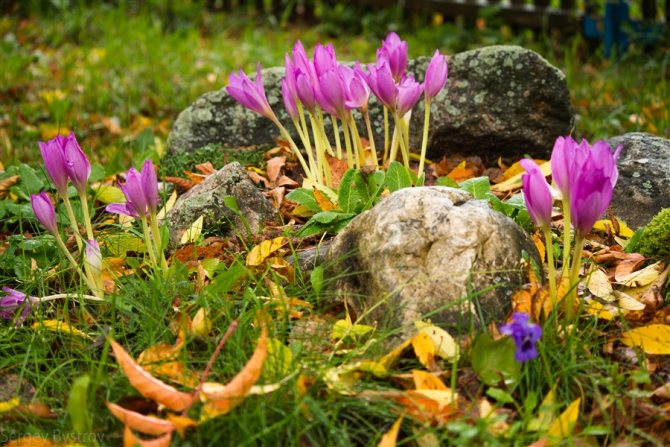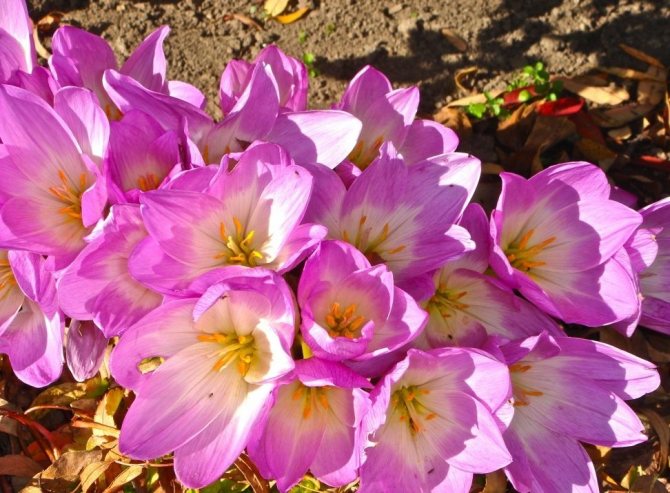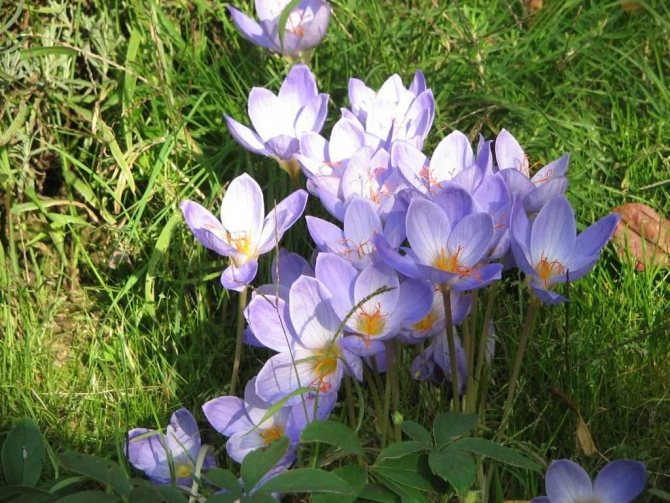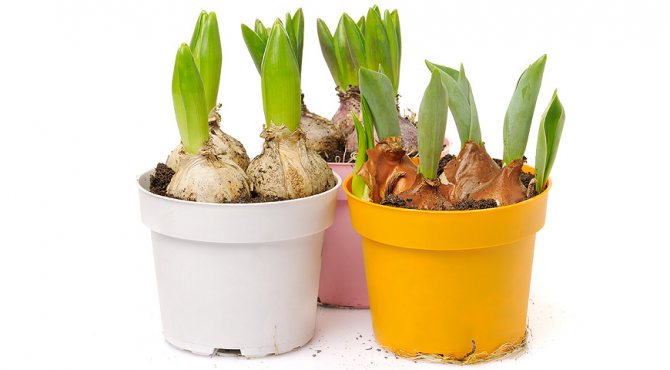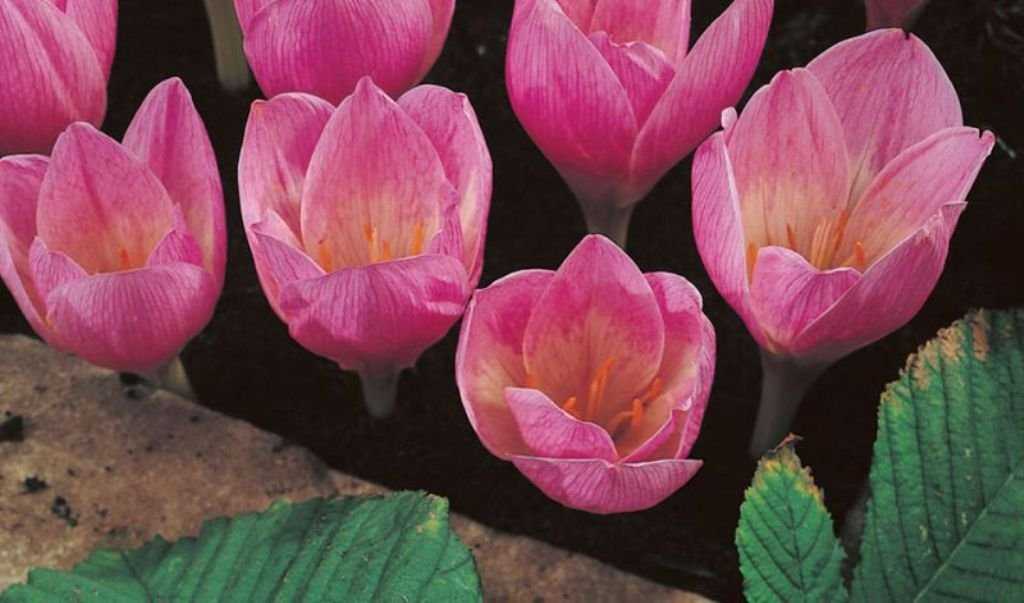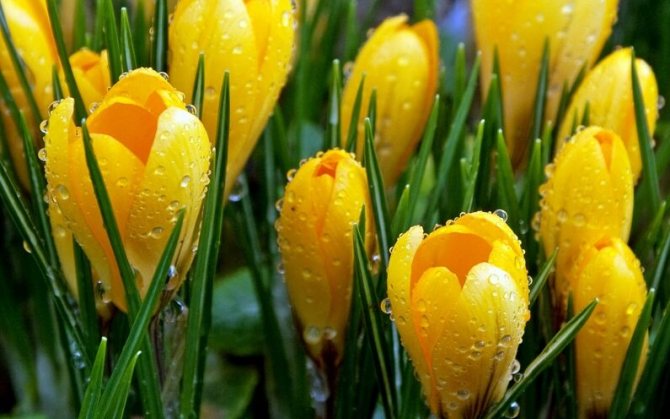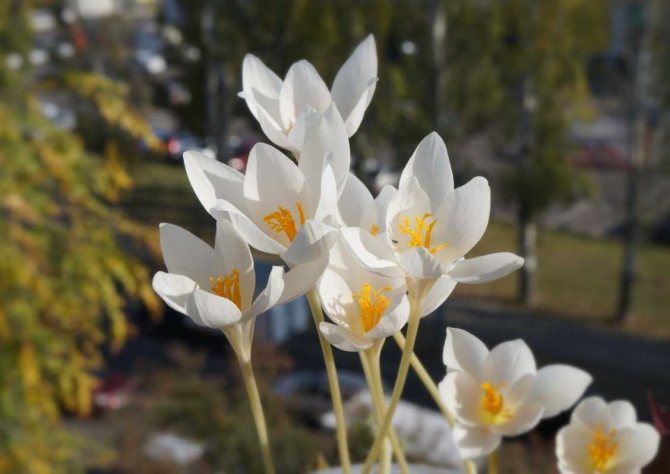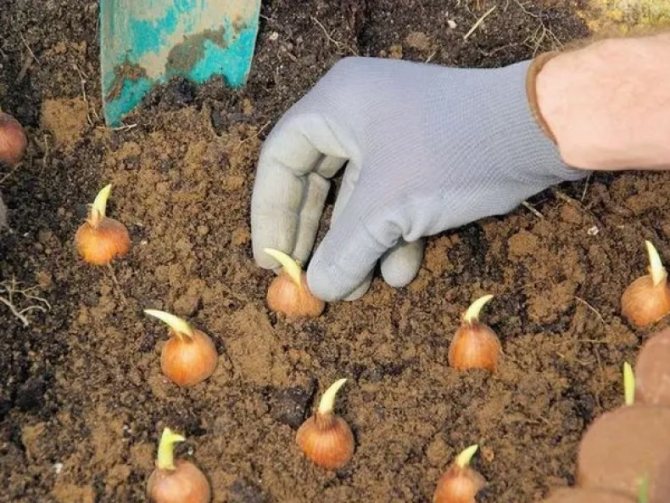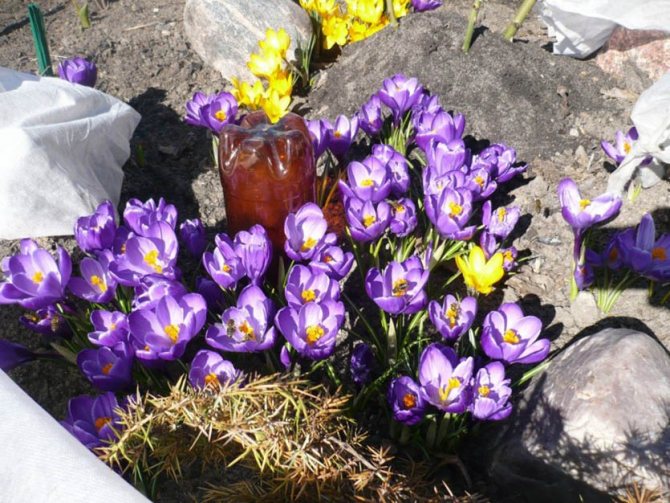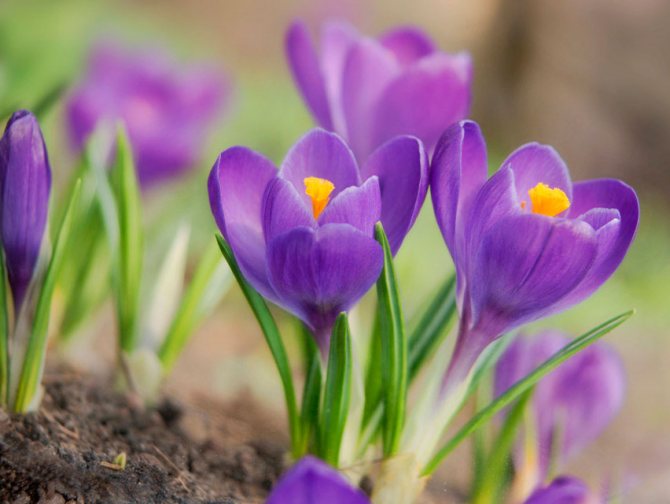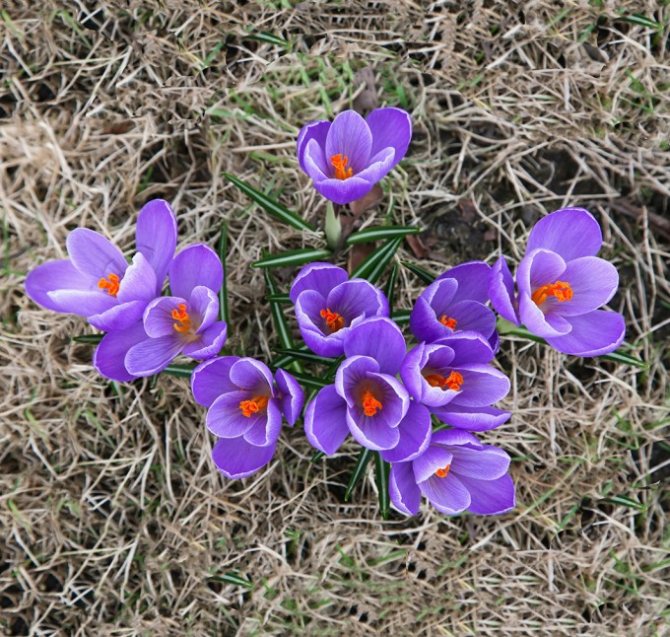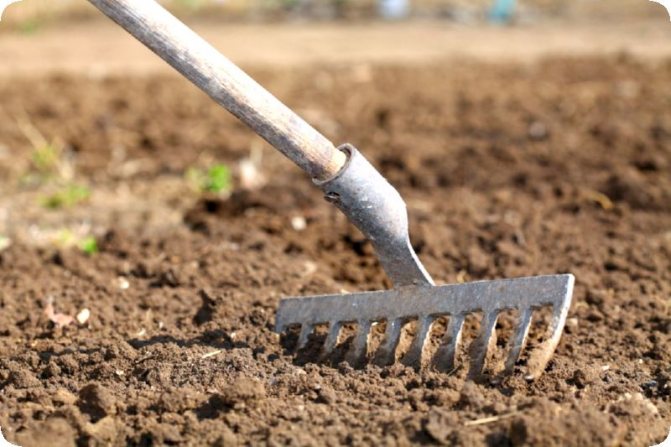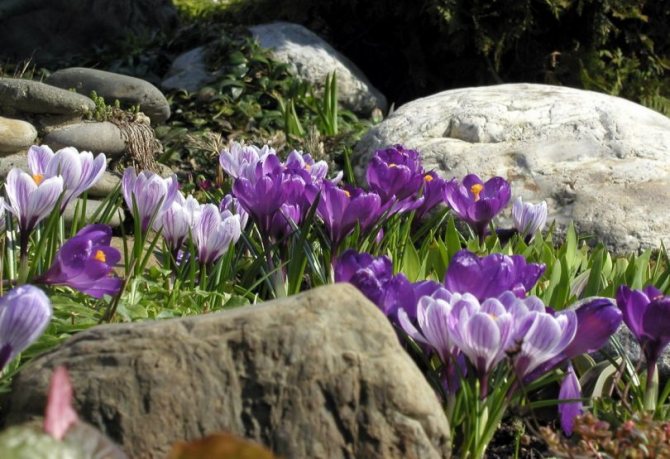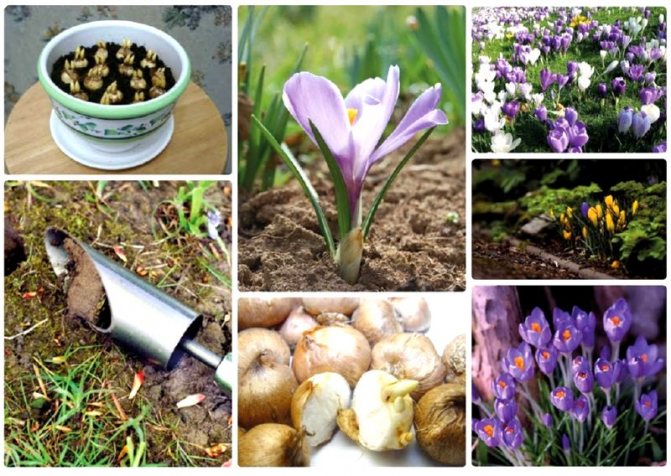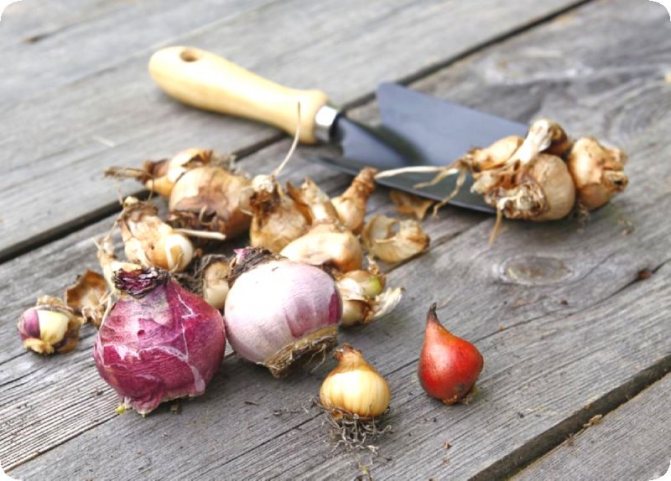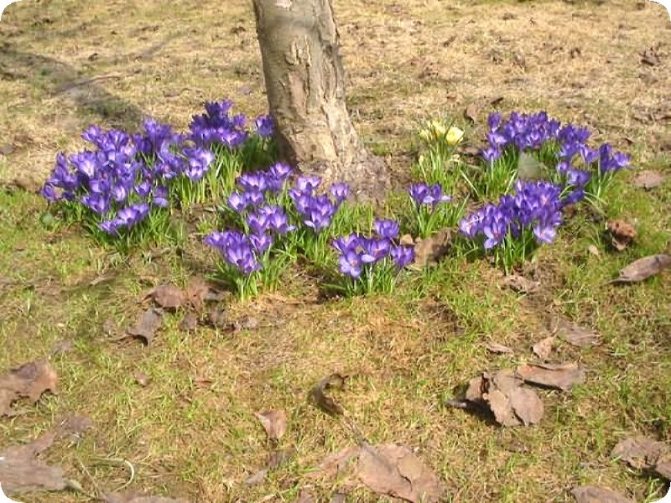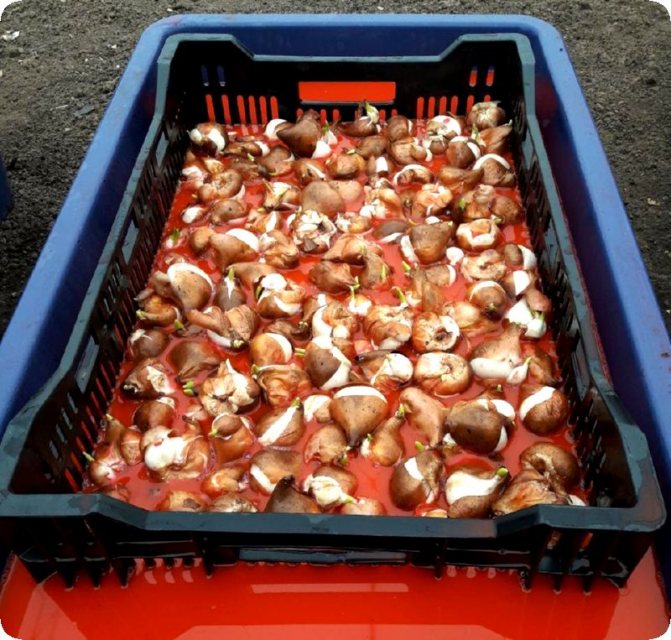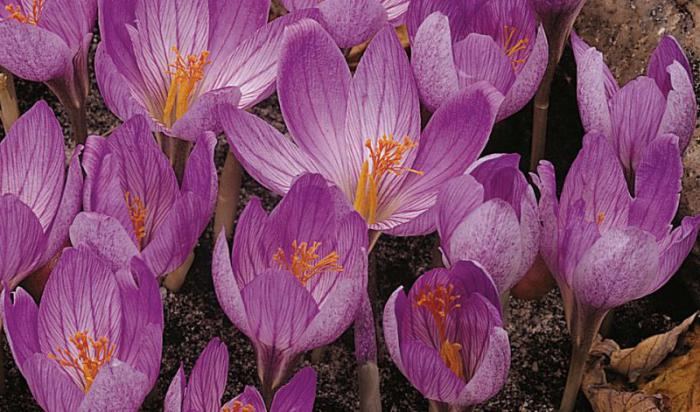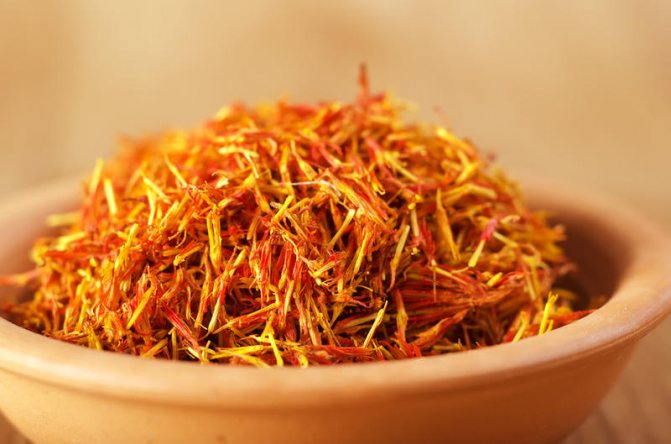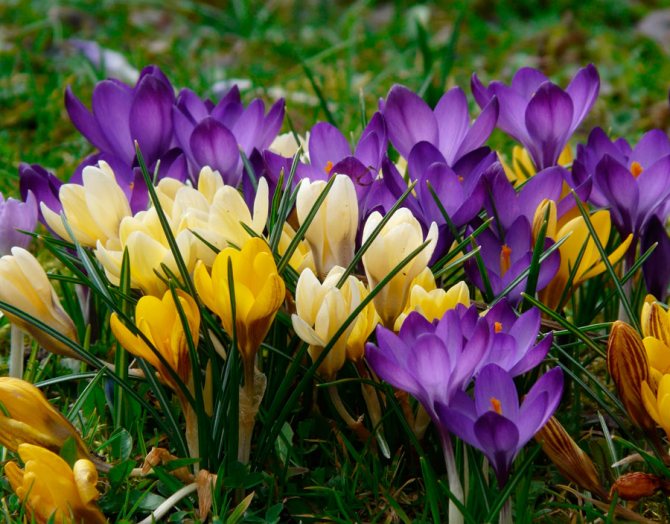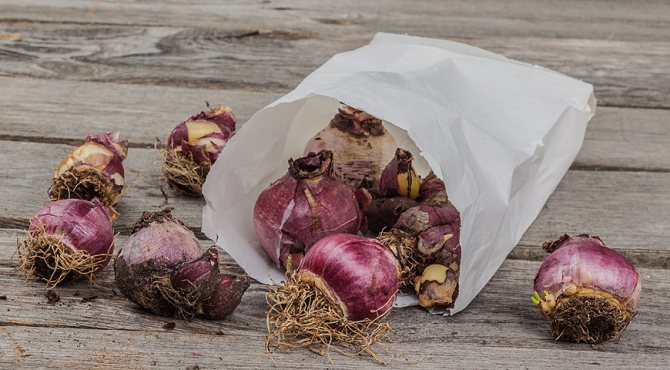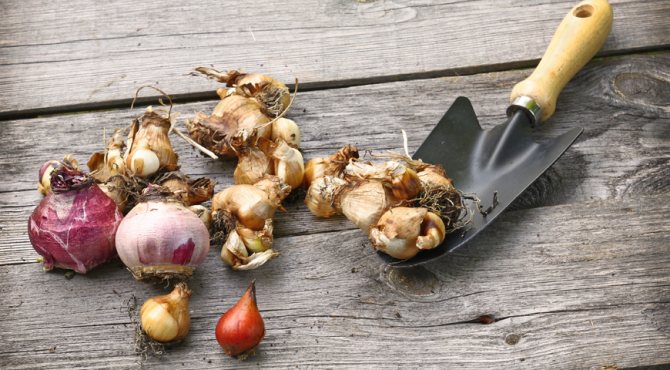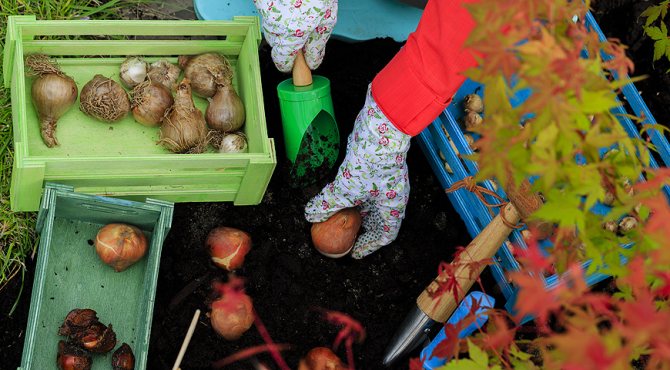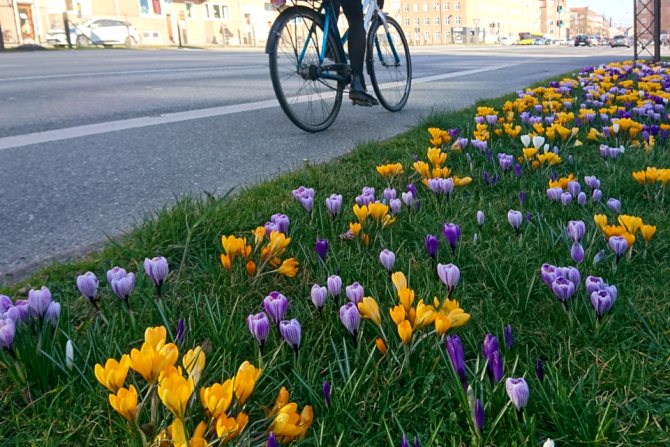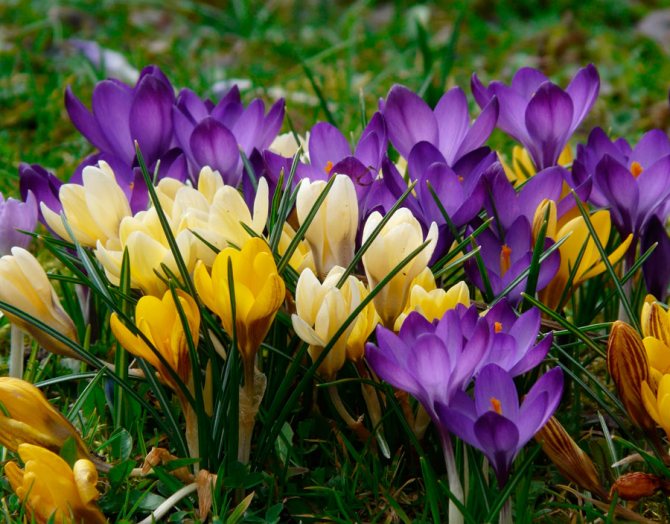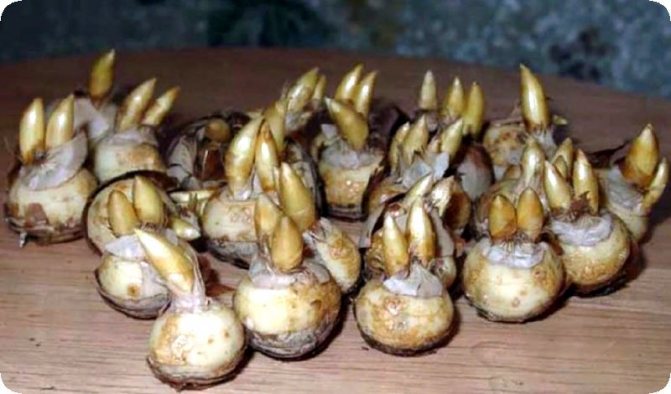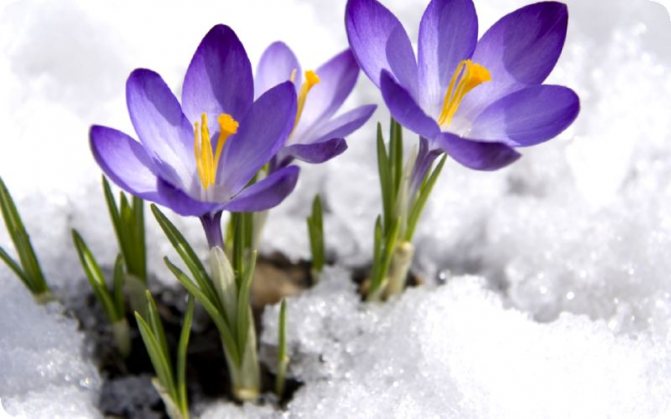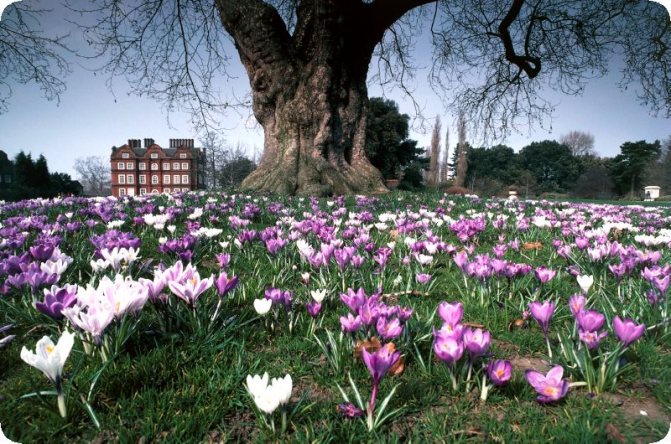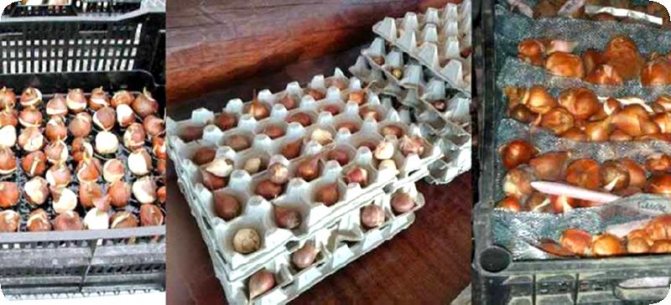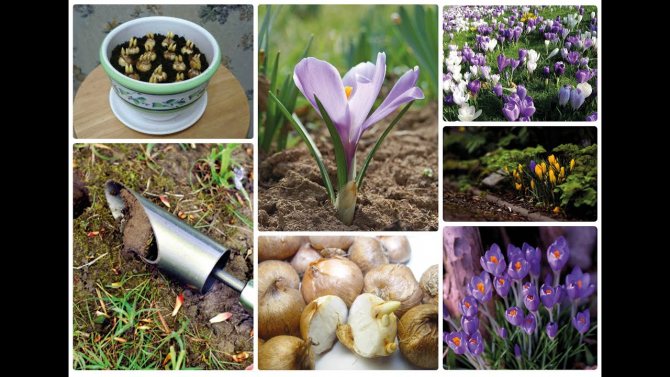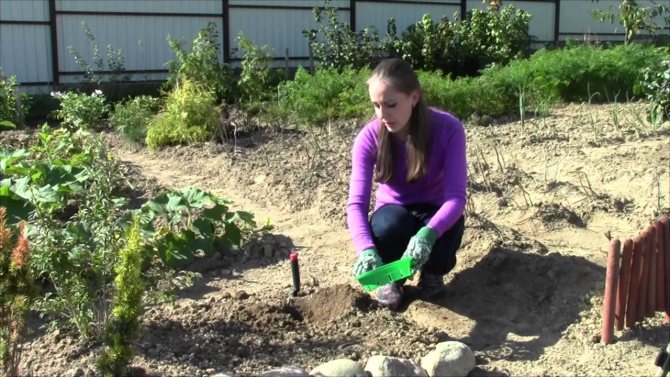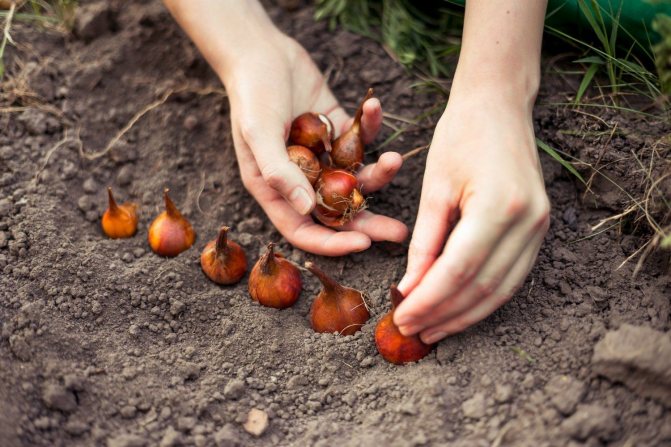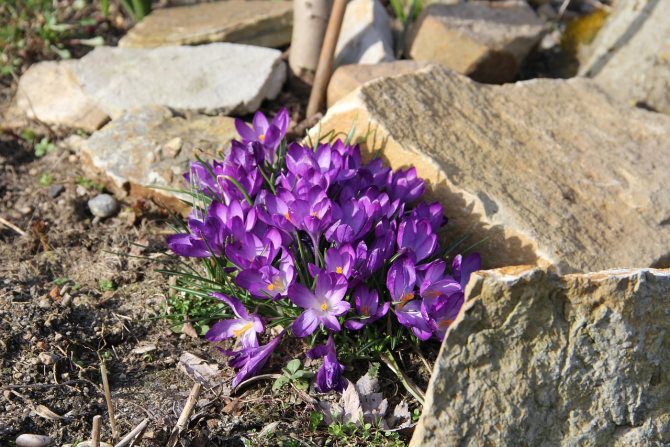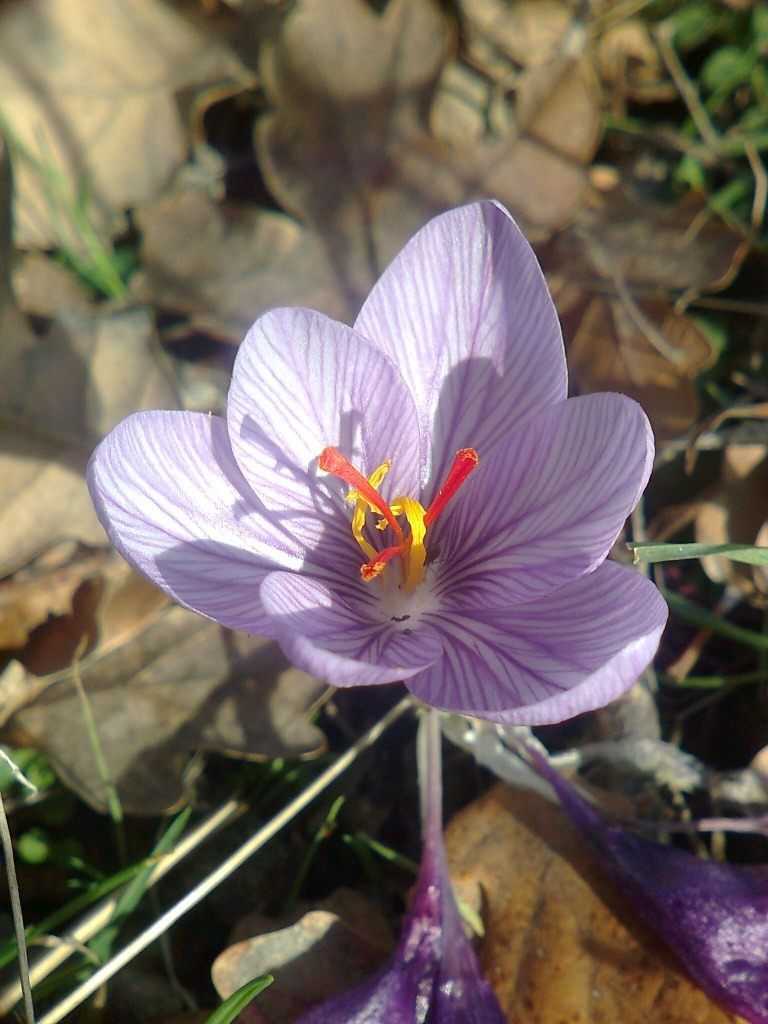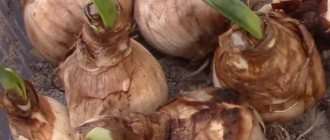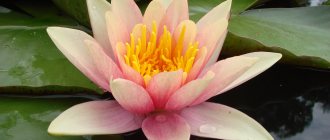Crocus or saffron is one of the primroses of the bulbous family, very popular with gardeners. This article contains information on planting crocuses in the fall: when and how to plant.
There is a group of crocus varieties that bloom in the summer. And although the flowering period of the plant does not exceed two weeks, you can choose the varieties so that you can admire the bright floral carpet for a long time.
Crocuses are often planted together with other snowdrops: muscari, hyacinths, tulips, forming bright spring flower beds.
Getting to know the autumn crocuses
Crocuses, or saffron, are the favorite of primroses. They are easy to grow and even easier to care for. But out of 15 groups, including almost 40 species of crocuses that are actively used in gardening, far from all are spring flowering plants.
A large group of crocuses blooms in the fall, towards the very end of the season. Autumn crocuses bloom after the beginning of leaf fall, and this spectacle - the contrast of a typical spring miniature flower and a garden withering for the winter - cannot leave you indifferent. Such species bloom as briefly as spring species, but much more spectacularly.
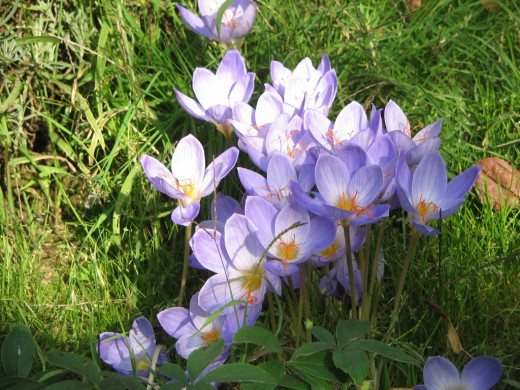
Saffron, or beautiful Crocus (Crocus speciosus).
Like spring species, autumn crocuses are suitable for growing as a garden plant, and in a pot and even indoor culture. True, in the last rank, their flowering periods are shifted and depend on when the bulb is planted, and not on the natural cycle. It is better to use them:
- "Wild" spots under shrubs and trees;
- as touching accents in small groups scattered around the garden;
- in the borders and in the foreground, along the edge of the ridges;
- near water bodies and other water bodies;
- to decorate the lawn;
- as a seasonal accent on alpine slides or rockeries.
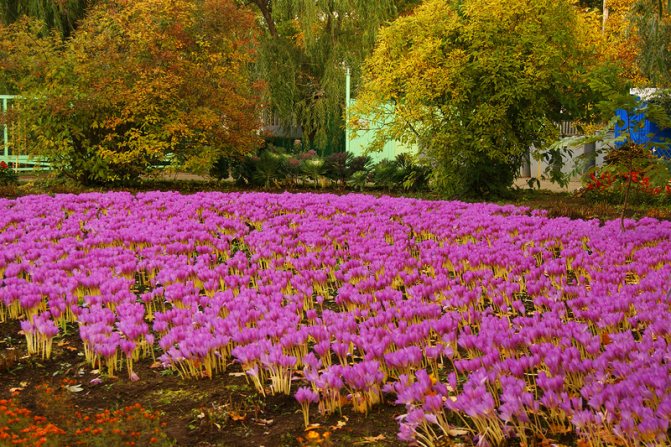

Crocuses: early varieties (video)
Also, during wet weather, an outbreak of fungal diseases can occur. Most often, corms suffer from this. They wrinkle and soften, colored spots appear under their shell.
Crocuses are beautiful early flowering plants, they look very impressive in the form of small curtains, they also go well with other spring bulbs. They can be used to decorate alpine slides, they also look spectacular against the background of conifers. In summer, annuals can be planted on crocus beds.
The best types of autumn crocuses:
1. The only yellow crocus of Sharoyan, whose color is dazzling saffron. It has wide leaves and a large, graceful flower that looks like a small sun. This crocus blooms in September and October.
2. Crocus mound (or valley) in height will not exceed 12 cm, but long, up to 6 cm petals with a milky base color and purple stripes-strokes are decorated with charming orange stains in the throat.
3. Banat crocus with beautiful linear autumn leaves up to 15 cm long and flowering that lasts for a month, during which each bulb produces 1-2 flowers to the height of the leaves. Its flowers are very large, showy, a bit like irises, with almost five centimeter long perianth lobes, yellow-lilac anthers and cold lilac color.
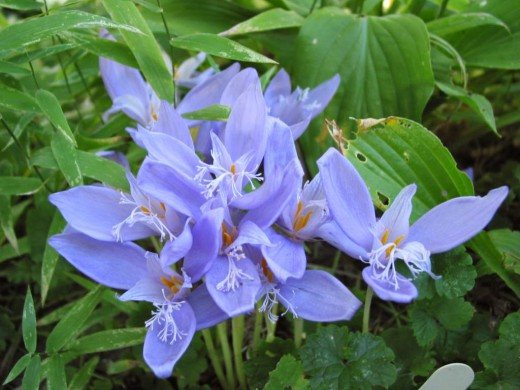

Saffron, or Banat Crocus.
four.The crocus is pretty with almost round perianth lobes, a surprisingly lush bunch of stamens and a beautiful play of color - dark purple on large veins and lighter, watercolor on the petals themselves. Its leaves bloom only after flowering, prolonged, exciting both September and October.
5. Crocus Pallas, whose flowers seem to be outlandish stars. This is a plant with narrow leaves that bloom only in spring, the flowers of which appear in the second half of September and even though they reach a height of only 5 cm, they are very effective. Reaching almost 5 cm in diameter, they are distinguished by a lily-shaped shape and a very light, shining white-lilac color with a beautiful bunch of stamens.
6. Beautiful crocus - one of the largest autumn-colored crocuses. Its leaves develop in spring and reach a length of 30 cm. But the real "show" begins in September, when the corms release flowers up to 7 cm in diameter, white or lilac, with surprisingly touching longitudinal veins, watercolor stains, the ideal shape of wide, pointed at the edge of the petals and a symmetrical structure. Everything is fine in this crocus - both the bright orange columns with yellow specks of dust in the center, and the translucent texture of mother-of-pearl petals. Crocus speciosus has a huge number of intense and dark blue, blue, lilac varieties. Among them, the most popular are:
- variety "Oksinan" with a dark purple, ultramarine tint, color of wide perianths and gracefully pointed ends of the petals;
- grade "Albus" with an original cream tube and snow-white petals;
- variety "Cassiope" with amazing contrasting veins on the most delicate blue flowers;
- variety "Aitchisonu" with large, more than 7 cm in diameter, lilac flowers;
- variety "Conqueror" with azure blue huge flowers;
- variety "Artabir" with a sky-blue color, accentuated by dark veins.
The best varieties for planting in the fall
All varieties of crocuses can be divided into autumn and spring, that is, those that bloom in autumn and those that bloom in spring. In garden culture, only large-flowered and botanical species of spring crocuses are mainly used, autumn ones are much less common.
Botanical
They are distinguished by abundant flowering and pleasantly scented flowers. They reach a height of no more than 8 cm. Blossom, one might say, right in the snow. Among them, the following varieties are distinguished:
- Blue Pearl... It is characterized by light blue flowers. Flowering begins very early, it is usually massive and friendly.
- Prince Claus. The color of this variety is very original. Against the background of white petals, a purple stripe stands out very clearly. It usually blooms early and abundantly.
- Cream Beauty. Pale yellow goblets of flowers with bright yellow stigmas. Differs in very abundant flowering.
- Princess Beatrix. The flowers are blue with a yellow bottom.
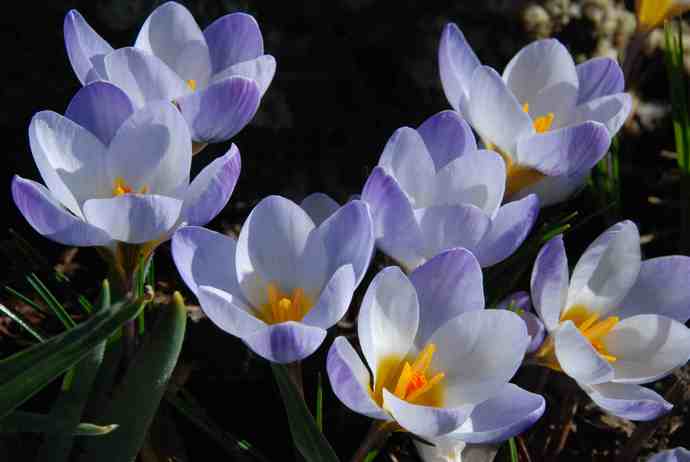

Large-flowered
The most widespread and well-known group of crocuses. It differs from the rest in larger flowers and later flowering. Almost all large-flowered crocuses are Dutch hybrids obtained by crossing different species. They are characterized by a very wide variety of colors.
They bloom about a week later than botanical varieties, somewhere in the second half of April. Often the timing of flowering depends on the weather conditions of a particular year. Below are the best varieties of large-flowered crocuses:
- Joan of Arc. It is the best variety of white crocuses. The flowers are pure white flowers with a lilac bottom, their height is no more than 4 cm. The flowering period occurs in the second half of April.
- Pickwick. Has a very original color scheme. On a pure white background, lilac strokes are located. Due to its unusual color it is a very popular variety.
- Flower Record. Flowers about 4cm high, deep purple in color with a darker base.It blooms in late April, can be used for group plantings and when creating a rock garden.
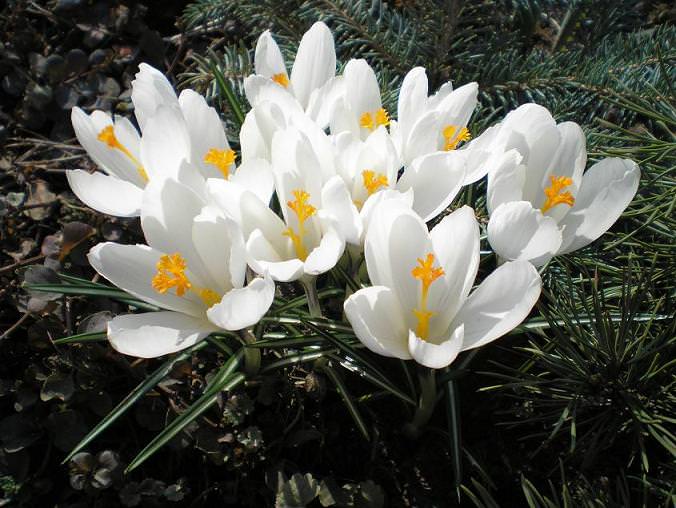

Autumn crocus varieties
The flowering period of these crocuses falls in the fall, but depending on the region, it can last until December. In this group, only leaves grow in the spring, and peduncles appear in the fall after they die off. The following varieties are most common:
- The crocus is beautiful. It is the earliest of this group, blooming in early autumn. Its flowers have a rather varied color, you can find white, purple, blue inflorescences. It is appreciated for its absolute unpretentiousness.
- Crocus Zonatus. Blooms from the second half of September or October. Deep pink flowers with a yellow core. The size of the flowers is about 4 cm in height. The inflorescences of this variety are characterized by a slight sweetish smell.
- The crocus is pale ocher. It has rather small milky inflorescences, unpretentious.
- Long-flowered crocus. Late flowering variety, its flowering period is in November.
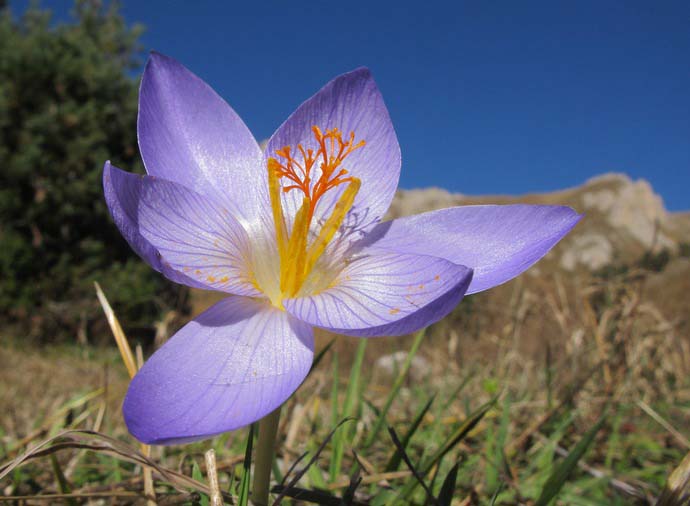

Conditions comfortable for autumn crocuses
Autumn crocuses are much more flexible in terms of their lighting requirements. Crocus Sharoyan and the valley loves shade or partial shade, but for the rest of the species it is better to provide diffused lighting, sunny and bright places, or at least a partial shade location. For autumn crocuses, a growing strategy with a sunny location in spring and autumn and shaded in summer is suitable.
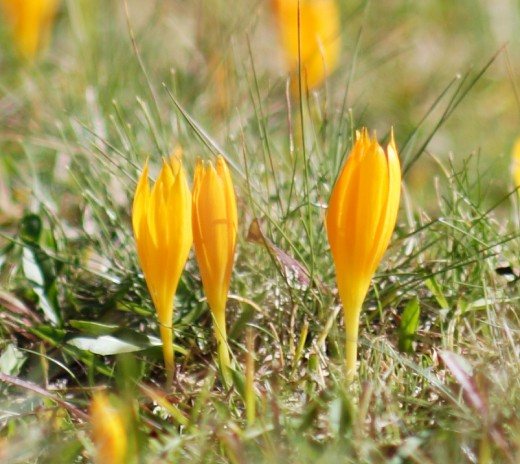

Sharoyan's saffron, or Sharoyan's Crocus (Crocus scharojanii). <>
Crocuses do not like winds and drafts, so protected areas are chosen for them. The thing is that flowers of these plants are sensitive to cold autumn winds, and the more protection they are provided with by their “neighbors”, the better.
The place of planting of autumn crocuses must be selected so that during the dormant period they do not suffer from getting wet, grow dry and warm. That is why you need to choose either elevated, well-drained places (for example, on alpine slides and rockeries). Another option is to lay the drainage during disembarkation.
Pay attention to the soil. For crocuses, choose light, loamy soils that allow water to pass through well. The only exceptions are Dutch varieties and hybrids that can tolerate even heavy soil. Be sure to make sure that the soil is not acidic or alkaline: crocuses love neutral soils. But they are not so demanding on fertility: the richest soils and rather scarce soils are suitable for crocuses.
Characteristics and description of saffron
Crocus flowers photo, which fully testify to all their unusualness and beauty, belong to the Kasatikov family. There are about 20 varieties. In its natural environment, it grows on rocky slopes and meadows located high in the mountains of the Crimea, the Caucasus, the Mediterranean, Central Asia, as well as in central Europe.
As a rule, almost all varieties bloom with the onset of spring, but you can find varieties that bloom in the fall, the so-called autumn-flowering crocuses.
white crocuses
A feature of unusual primroses is lack of aerial shoots... In addition, they are characterized by large, upward-looking inflorescences. During their bloom, the blossoming flowers can be likened to goblets or funnels, consisting of six petals growing from a corm. After the buds have fully blossomed, they are cupped or star-shaped.
On personal plots, you can grow not only the original species, but also beautiful and large hybrids bred by professionals. The timing of planting crocuses in the fall in the Moscow region, for example, is similar to growing in other cities of the country.
The stigma of saffron is dried and used as a natural yellow dye or spice in many countries since ancient times.Not all varieties are suitable, but only crocus sowing, Altavsky (Crocus alatavicus) or fine saffron, from the “nominal” variety Palasi, also known as Crocus pallasii. More information can be found here.
Features of planting autumn crocuses
Before planting crocuses, the area for them must be prepared. Mix sand or fine gravel into the soil to improve drainage, and add mature manure, leafy soil to poor soil. Autumn crocuses will also respond with gratitude to the application of phosphorus-potassium fertilizers (instead of nitrophoska it is better to use superphosphate and potassium nitrate). It is better not to use peat or to extinguish it with lime. On those sites where there is a high risk of getting wet, make raised ridges or lay drainage at a depth of 30-40 cm.
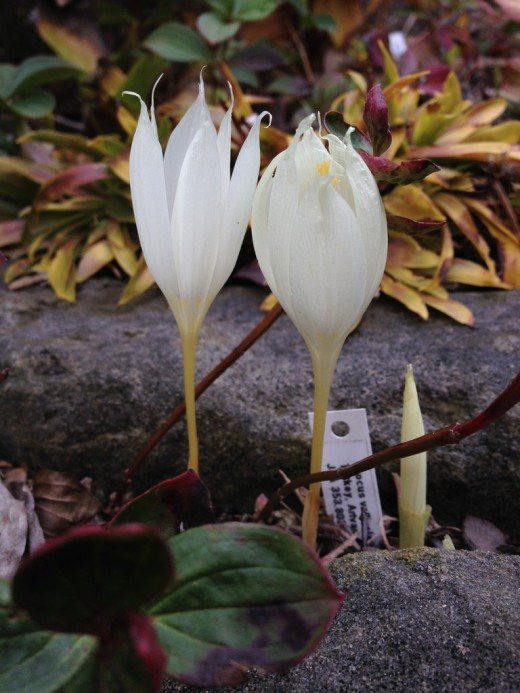

Saffron, or Crocus valley (hill) (Crocus vallicola). <>
Autumn-flowering crocuses require a slightly different approach to planting: if spring crocuses are planted in August-September, then autumn-flowering crocuses need to be bought before flowering, which traditionally begins in September. The best dates for them are from June to the end of the first decade of August. Do not buy flowering bulbs - they will be weakened and take several years to recover.
Before planting, inspect the bulbs again: they should be heavy, with dense shells, not crumpled and soft, with a clearly visible renewal bud (small tubercle). Autumn blooming crocuses should soon "wake up", and if the buds are imperceptible on them, it is better not to plant them at all or plant them in a pot and watch for signs of growth.
Autumn crocuses are planted only in groups of 5 or more, placing the plants at a distance of 5-6 cm between the plants. Crocus bulbs are planted at a traditional depth equal to twice the height of the bulbs themselves (5 to 15 cm). On heavy soil, leave a distance equal to the height of the bulb from the top of the bulb to the edge of the soil. It is not necessary to strictly follow the centimeters: crocuses, unlike many bulbous ones, form retracting roots and young bulbs themselves will settle in the soil at a comfortable depth. After planting, mulch the soil with sand to keep out slugs. Be sure to mark the landing site with sticks or other markers.
Landing features
All types of spring-blooming crocuses in the Moscow region are planted from mid-September to October. They will bloom next spring immediately after the snow melts. Autumn-flowering varieties are planted in early August, they can please with flowering in the fall of the same year.
Areas for planting crocuses in the open field should be chosen correctly. They should be with well-drained soils, always without moisture stagnation in spring. If the site is swampy, preference should be given to the highest place on it.
Crocuses can grow on any type of soil, except for acidic ones. But most of all they like loams. If the soil is too poor in composition, then it is recommended to apply organic fertilizers, for example, humus or compost, before planting.
Crocuses prefer places well lit by the sun, but they develop quite successfully in partial shade, in which case flowering occurs somewhat later. The duration of the flowering period varies between them. It depends on the variety, weather conditions, location.
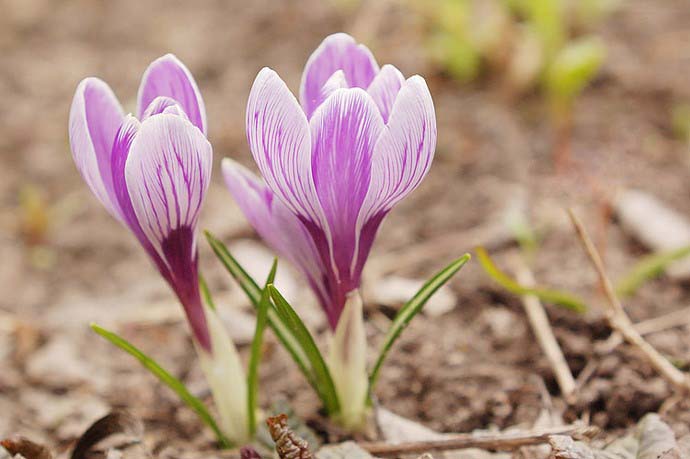

Crocus bulbs are planted in autumn to a depth of no more than 7-8 cm, the distance between them is kept about 10 cm. After the end of planting work, the crocus beds should be mulched with peat. Also, during the winter, you need to ensure that their bulbs are not eaten by mice.
Autumn blooming crocus care
These small plants, offering to enjoy the spring bloom during the atypical season, are easy to grow. Crocuses do not need watering, except for the coincidence of winters with little snow and extreme droughts in spring, when during the period of active growth of the foliage of autumn crocuses, it is necessary to replenish the moisture requirement of the bulbs and water the crocuses at least several times. Plants do not need watering in autumn.


Saffron Pallas, or Crocus Pallas (Crocus pallasii).
During the entire phase of active development at the beginning of the season, crocuses need potassium and phosphorus. They can be fed once in early spring. Be careful when adding nitrogen for autumn crocuses: the vigorous growth of greenery can be detrimental to flowering at the end of the season. Crocus fertilizer is not applied in autumn.
Colchicum in garden design
The unpretentiousness of crocus flowers and their enchanting bloom makes these flowers welcome guests in any garden, especially in autumn compositions. They are often planted in flower borders, in complex mixborders, which is very practical, since by the summer they completely lose their decorative effect and need “reliable cover” by neighboring plants.
Kolhikums will perfectly decorate the alpine slide and the shores of a small reservoir. They will perfectly fit into the frame of an elegant seasonal flower bed and will revive the autumn lawn. It is an amazingly functional plant and is even suitable for cutting and container planting on a terrace or balcony.
<2010 - 2019, Planting a Garden. All rights reserved.
Similar posts
Garden in October
Bright colors of a dull pore
How to keep dahlias in an apartment
Digging and replanting autumn crocuses
Crocuses can be transplanted and transferred to a new place at the same time as the planting is carried out - from June to August for autumn flowering species. Autumn crocuses (if you do not plan to increase the number of plants and propagate crocuses, donate them to friends-neighbors or sell them), do not replant more often for 3-5 years. Wait for signs of overflowing "nests" and only then plant the bulbs. So the flowering will be more beautiful, and the bulbs will be stronger.
After digging, the bulbs must be dried at room temperature in a well-ventilated place for 2-3 months. After drying, old roots and exfoliated, bad scales are removed from them, sprinkling all damage with wood ash. It is better to discard bulbs with traces of rot right away.
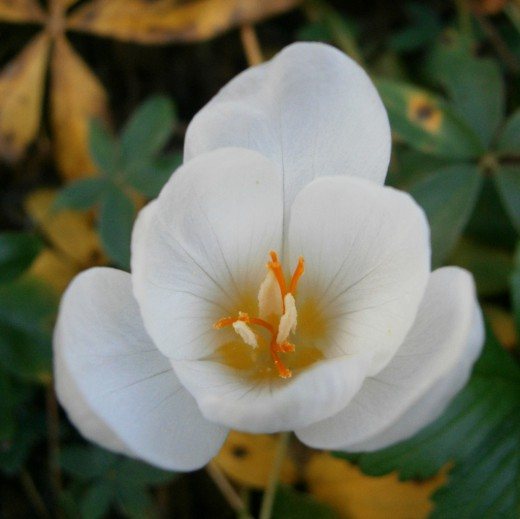

Saffron, or Crocus pretty, just as pretty, 'Zephyr' variety (Crocus pulchellus).
Autumn care
Crocuses are unpretentious, even a novice florist can handle their cultivation. But over time, their nests grow, so every five years it is recommended to dig them up and replant. This technique promotes better growth and more abundant flowering. But you need to do it right. The bulbs are dug in mid-summer when they are dormant.
After the crocuses have been dug up, they must be dried for two months. After that, in September, after all diseased bulbs have been rejected, it will be possible to start planting.
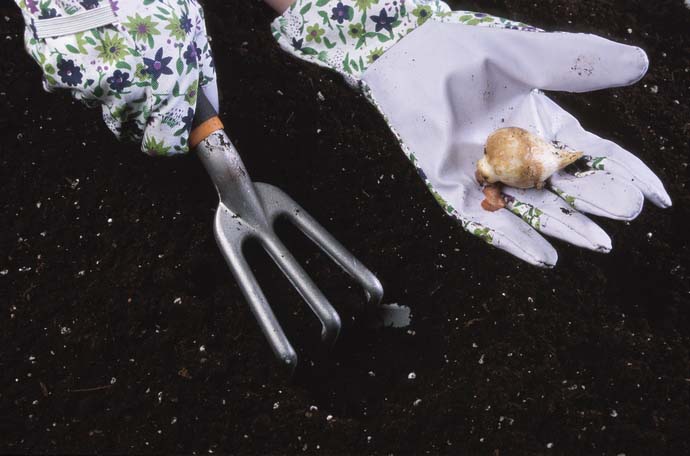

From the care measures, fertilization should also be noted. This must be done twice a year. The first - immediately after the snow melted, at this time, the crocuses are given nitrogen fertilization, the second - during flowering, for this, a phosphorus-potassium group of fertilizers is used.
Diseases and pests
Autumn crocuses are considered to be more “reliable” plants than spring-flowering species. They most often suffer from rot caused by excessive soil moisture, but are less likely to be affected by other diseases. In new varieties, dry rot is common, manifesting at the beginning in small specks, then merging into whole foci. Rotted bulbs must be thrown away and destroyed immediately. Rodents love to eat with them, therefore, when close to the nests and increased activity on the site, it is better to plant the bulbs in special nets.
Reproduction methods
Crocuses reproduce by daughter bulbs, the so-called babies, which are separated from the mother plant during development. They bloom only after 3 years. Every year, babies are formed near the mother's bulb, and there are too many of them. As a result, crocus flowers begin to shrink.That is why once every five years, the overgrown clumps of crocuses must be dug up and planted.
In rare cases, seed propagation can be used. It is very time-consuming and therefore mostly used by breeders to develop new varieties.
Tuber processing
When choosing planting material, it must be remembered that the bulb must be whole, firm, without sprouts and damage to the skin. Its size can vary from 9 to 12 cm. It is such a head that can accumulate a sufficient amount of substances over the winter to delight the eye with amazing colors in the spring. The number of buds that a plant forms depends on the size of the tubers.
It is customary to disinfect tubers before planting. There are various drugs available for this procedure. Most often, antiseptics are used, specially created for the treatment of bulbous and other cultivated plants:
- Fundazol;
- Karbofos;
- Maxim;
- Speed;
- Vitaros.
These broad-spectrum fungicides reliably protect the bulbs from diseases and rot, make them resistant to changes in temperature and humidity. The preparations are very easy to use. They are usually sold in 2 ml packs. It is necessary to dilute 1 ampoule of disinfectant in 1 liter of water and soak the planting material in the resulting solution for 20 minutes.
If you don't have a special tool at hand, you can use an old and proven recipe. Dissolve 5 g of potassium permanganate in 1 liter of water. A weak solution of potassium permanganate is a good antiseptic. If you put crocus bulbs in it for half an hour, the effect will be the same as after known fungicides.
After disinfection, the flower tubers do not need to be washed. It is enough to dry them. Immediately after the procedure, the material is ready for planting.
Application of saffron in the landscape
Crocus-like flowers blooming in autumn will look great next to such beautiful bushes, just remember that Crocus flowers like to be in the foreground or next to neighbors of the same size. With amazing colorful plants, you will be able to decorate your garden and enjoy them for a long time. But the main advantage is that they do not need special care, which means that even amateur gardeners can grow them.
When decorating your garden, do not forget to keep in mind that all plants must be in harmony with each other. If you are wondering what flowers to plant next to a crocus, then you should find out that any short plants that bloom simultaneously with primroses will look great next to them.
Bloom
You can often come across a question from inexperienced florists who came up with the idea to grow crocuses when these plants are blooming.
The flowering period can be varied depending on the variety. Goblet flowers, located on short stems, have 6 petals. After blooming, the flowers take on a star-shaped or cupped shape. The inflorescences are colored in various shades. Pollination of flowers is carried out by insects.
Reference! A combination of yellow and red crocus looks very impressive on a flower bed. Flowers grow quickly enough, but not every variety can please with flowering in the year of planting.
Chrysanthus
Ornamental plants of the chrysanthus group contain a large number of crocus varieties that delight with yellow and light blue flowers. Among the most spectacular varieties, it is worth highlighting:
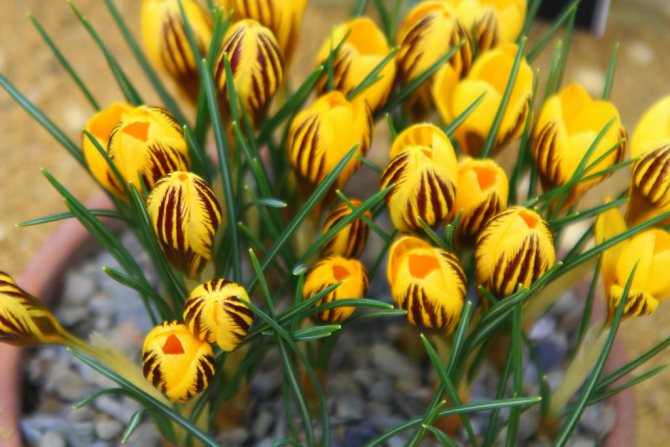

Crocus Gypsy Girl
- Gypsy Girl is a variety whose cupped flowers are wide open. The inner surface of the petals is painted in yellow tones, and the outer surface in creamy yellow shades.
- Marietta is an amazing plant that effectively combines the bright yellow and cream tones of the petals. The petals are naturally oval shaped. Yellow crocuses can decorate any flower bed.
- Lady Keeler is an ornamental crop whose flowers look completely flat despite their cupped shape. The diameter can be up to 3 cm across.
- Saturnus is characterized by flat, wide-open flowers, the diameter of which is in the range of 32-35 mm. The tops of the lobes, painted in a creamy palette, are slightly elongated. At the base of the lobes, spots of a brown-green hue can be found.
Large-flowered crocuses
Osteospermum flower - varieties and varieties
Large-flowered crocuses, which delight with gorgeous flowering, were to the taste of most flower growers. Below are the most popular varieties.
- Albion, characterized by goblet flowers painted in white tones. The diameter of the inflorescences reaches 4 cm. The lobes have rounded outlines.
- Vanguard is a type of saffron with cupped flowers of a lilac-blue palette. The diameter of the inflorescences is within 3.5-4 cm.
- Jubilee - crocuses, in which bluish flowers, endowed with a goblet shape, contain a purple-purple tint.
- Sniper Banner is a type of crocus, distinguished by goblet flowers. The mesh lobes are oval in shape. Their outer surface is painted in pale lilac tones, and the inner one resembles a dark lilac mesh.
- Caitlin Parlow is a variety whose white flowers look especially luxurious and elegant. Inner lobes with short lilac strokes are located near the base.
Growing muscari in flowerpots
Besides the question of when to plant crocuses, another important question is the choice of the variety. Not every species is suitable for autumn planting. It is best to buy bulbs from trusted florists and flower shops, rather than in the market.
- Spring. The inflorescence is lilac, sometimes purple veins are found on the back of the petals;
- Two-flowered. The shade of the inflorescences is from white to bluish with a purple tint, sometimes there are purple streaks on the petals;
- Crimean. The inflorescence is white with a lilac shade, the “throat” is bright yellow;
- Crocus Adam. The shade of the petals can be from light lavender to intense purple;
- Golden. The shade of the petals is golden yellow, most often found on the rocky slopes of Asia Minor and in the Balkans;
- Yellow. The flowers are bright orange, the leaves are very thin, dark green in color. This variety has one distinguishing feature from other species - the corm is wrapped in a filmy shell that protrudes from the ground, giving the flower the appearance of a small bunch.
Saffron in the country does not need careful care. It includes:
- Watering;
- Fertilization;
- Protection from pests and diseases;
- Loosening the soil.
- 1. Watering.
Crocuses do not need regular watering in the country, and do not tolerate when moisture stagnates in the soil. If an excess of moisture appears in the fall or spring, then it must be loosened up. Abundant watering is necessary only during the flowering period - in spring and autumn. In the event that there is little snow in the winter and little rain in the fall, then the saffron needs additional watering.
If in the latitude where saffron is grown, winters are snowless, then with the appearance of the first shoots it must be watered. In this case, you need to weed the soil just before watering. During watering, it is recommended to make sure that no water gets on the leaves, otherwise they will begin to turn yellow.
- 2. Fertilization.
The introduction of mineral and organic fertilizers is the main one in flower care. Saffron top dressing has a number of distinctive features. Firstly, the introduction of fresh organic fertilizers is not allowed. This can provoke the occurrence of various diseases.
It is best to give preference to peat, completely decomposed manure or a variety of mineral dressings.
With the onset of spring, when the active growth of the flower begins, it is necessary to scatter fertilizers over the snow. When the growing season begins, urea can be added. A large amount of nitrogen in the soil will provoke active leaf growth, which can cause fungal diseases in wet weather.
- 3. Pest and disease control.
If you follow all the rules of agricultural technology, then the plant will practically not be affected by various diseases and parasites. The exception is rodents, which like to gnaw the planting material. To prevent this, the bulbs that are drying cannot be left unattended, or they can be removed to a safe place where rodents cannot get to them. You can store crocuses in an egg box.
Sometimes you will notice that there are small holes in the bulbs. They appear from the larvae of the click beetle. The larva is covered with a hard yellow shell.
To get rid of the click beetle at the end of April, you can scatter last year's rotted grass, hay or straw over the site. Moisten and cover with boards. After the bugs gather there, the trap must be collected and burned. Slugs can also be found on plants. They need to be collected by hand.
If in a flowerbed where saffron grows, there is an instance with a flattened flower with gray spots, then this is the first sign of a viral disease, which are carried by mice, aphids and thrips. The only treatment in this case is the immediate destruction of diseased flowers before the disease spreads further.
Saffron is one of the most beautiful plants to plant in the garden. Very often, it is treated exclusively as a spring flower, but it can delight with its flowering in the autumn period. It gained its popularity thanks to its graceful flowers. They can be of a wide variety of colors: white, bright yellow, blue, various shades of purple.
Crocus corms are located in the soil close to each other, since they are small in size, and the flowers look richer in dense groups. But keep in mind that the corms are growing by children, so the optimal distance between them is 3-5 cm. Planting crocuses in large groups makes it possible to get a charming flowering meadow-flower bed, which decorates a plot or garden in spring. After wilting, annuals can be sown in the place of crocuses.
The planting depth of crocuses depends on the size of the corms. Small ones are buried by 4-5 cm, and for large corms, a hole 10-12 cm deep will be required. Do not immerse them too deeply: crocuses have retracting roots, which, after the plants wilt, pull the corms deeper into the ground.
The process of forcing crocus corms in pots takes about 3.5 months or 15 weeks, so if you want to get crocuses for the New Year, they are planted in mid-September, and if by Valentine's Day, then in early October. And for a gift by March 8, crocuses should be planted around November 15.
Before planting for distillation, the corms must be kept in the cold. That is, you can buy crocus bulbs in the summer and then store them for 1 week at a normal summer temperature (30-35 ° C), then 2 weeks in a colder room, and until August 10 in a cellar or basement at a temperature of 17 ° C. And then until planting - in the refrigerator at a temperature of 9 ° C.
Then the crocus bulbs need to be planted in a pot with a lot of drainage. When forcing, the bulb is the plant's only source of nutrition. Sand is used as a soil for forcing.
Corms in pots are placed very tightly to each other, because they, like in a garden bed, will not grow and form children. In addition, the dense planting of bulbs in flowerpots gives a beautiful, dense, rich bouquet, which is not a shame to present for any holiday.
Read about caring for crocuses after planting - both in the garden and at home.
The main thing you need to know about planting lilies is that you plant them not for a year, or even for two. The bulbs of these flowers should grow in one place for about 4-5 years, gaining strength. Constant annual digging will weaken them, and, as a result, in the first year after planting, the flowers are smaller than in subsequent years.
Lilies can be planted in the ground both in autumn and immediately at the beginning of the growing season - in the spring.For example, I prefer to do this in the fall in order to achieve an earlier flowering. Such bulbs take root even before the onset of frost.
In addition, if you bought planting material in the summer, then until next spring it may deteriorate. Lily bulbs dry out faster than tulip bulbs, and moisture loss sometimes results in the plant not blooming. If you notice that the bulb has lost its elasticity, immediately plant it in the ground.
The only reason it makes sense to plant lily bulbs in the spring is to change the site. For example, you want to plant lilies on a site that is still occupied by other flowers whose growing season ends in October-November (for example, chrysanthemums). Or if you want to renew the soil on the spot under a flowerbed with lilies - add fertilizers, add fresh soil. Then, in the spring, it is advisable to dig up this area and only after that plant the lily bulbs.
As I already mentioned, lilies should grow in one place for at least 4-5 years. So choose a permanent site for your flower bed right away.
We suggest that you familiarize yourself with: When to collect nettles for drying
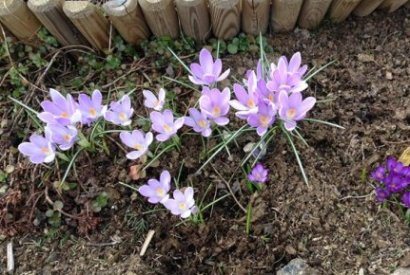

The soil at the place where the lilies will be planted must be well-drained, free to pass water during irrigation, so that moisture does not stagnate. The soil can even be half sandy or loamy - lilies do not like heavy soils.
Caring for lilies before planting - in order for you to admire the beautiful, large flowers, the land must be fertile, not empty. So a few months before planting in the ground, it is advisable to apply organic or mineral fertilizers. It is also advisable to fertilize the soil when the first sprouts of lilies appear in the spring.
The bulbs are planted to a depth of about 20 cm, but if they are too young and small in size, then the hole should be much shallower. So the planting depth depends on the size of the lily bulb.
I like to plant lilies in groups of 3-4 plants without making large gaps between them. This creates a very beautiful bouquet of lilies right in the garden. But do not forget that the bulb needs to grow, therefore, even with such a planting, the gap should be at least 10-12 cm. And if you also have a large-flowered variety, then it is better to plant them at a distance of 15-18 cm from each other.
The planting depth of lily bulbs depends on their size. Large bulbs need a hole 15-20 cm deep, and you also need to additionally make a depression for the roots - 10 cm. Low-growing varieties are planted to a depth of 10-12 cm and an additional 10 cm for the roots. Children can be dug in to a depth of 4-5 cm.
When you plant a lily bulb, sprinkle it on the bottom in the pits of fertile soil, and sprinkle it on top as well. So the bulb will receive a supply of mineral fertilizers to start development.
When planting lilies, follow the plant height rule. Lower varieties of lilies should be planted closer to the paths, and plants with long stems should be planted in the middle of the plot.
The lily area itself should be sunny, but it's good if a shadow gets there in the hottest daytime hours - this prolongs the flowering period, since direct sunlight burns the flowers.
Watering seedlings
- Planting: spring-flowering species are planted in autumn, autumn-flowering species in summer.
- Flowering: spring species bloom for 2-3 weeks in April, autumn - in September-October.
- Lighting: bright sunlight.
- Soil: permeable light loam, some species are comfortable even in heavy clay soils.
- Watering: only needed if there was no snow in winter and rain in spring.
- Top dressing: full mineral fertilizer in the spring in the snow and potassium-phosphorus fertilizer during flowering. Organic matter cannot be used.
- Reproduction: by daughter bulbs, and spring species can be propagated by seeds.
- Pests: field mice, wireworms, aphids, thrips.
- Diseases: viral diseases, gray rot, fusarium, penicillosis, sclerocial rot.
Transfer
The bulbs must be planted every 2-3 years. The time for transplanting is selected depending on the variety.
Fall-blooming crocus varieties should be dug up in June. Spring flowering plants are transplanted in September.
After digging, the bulbs are dried and cleaned of defective scales. Dead roots are cut off, and diseased bulbs must be disposed of without regret. Any mechanical damage is treated with a small amount of crushed coal.
Important! Until the moment of planting in the ground, it is necessary to move the planting material to the basement. It is advisable to dig up crocuses after flowering.
Plant crocuses before winter
In general, experienced florists do not advise planting bulbs later than mid-October. You can, of course, risk planting crocuses before winter, but, according to experienced gardeners, it is better to take care of purchasing the varieties you need early, than then risk the specimens obtained with difficulty.
No one argues that saffrons are unpretentious plants. It also happened that the planted bulbs in early November bloomed in early spring. So the winter then stood out warm without bitter frosts. As old people say correctly, it is not necessary once and for all. Planting crocuses in the last month of autumn is still risky.
Selection and preparation of planting material
The health and splendor of the flowering depends on the planted bulbs. If crocuses of poor quality were planted, then you should not expect good results in the spring. Before purchasing, the planting material is carefully examined for damage.


Experienced florists recommend paying attention to the following features:
- Crocus tubers should be dense, with dry scales. The presence of moisture indicates damage or a violation of storage conditions.
- Free from dents, cuts, stains, signs of disease and pests. Weakened corms will die in winter and will not produce healthy flowers.
- Lack of mold and mildew smell. Fungal spores provoke rotting and death of plants.
- Roots and stems indicate germination. These bulbs are not used for planting in the fall.
Important! For cultivation, large and visually whole tubers are selected. Such specimens will show the best results in the spring.
Proper storage
After the flower has faded, the leaves are cut from it. There is no particular need to dig up saffron every year for the winter. You can leave the bulbs in the ground, but they must be covered with spruce branches. If the bulbs are dug up for the winter, then they must be carefully sorted out, the bad ones must be discarded, the rest must be cleaned of dead scales. Unsuitable specimens are destroyed, and bulbs with minor damage are treated with brilliant green or sprinkled with ash. Having processed them in this way, the bulbs are placed in the shade for 7 days to dry. The next step is sorting. They are divided by size and laid out in containers that have ventilation holes. Stored home crocuses until the next landing.
Watch the video! How to plant crocuses
We plant crocuses at home in a pot
For the soul!
Now you can buy fresh flowers all year round, at any time of the day and the assortment is stunning. Popping into a flower shop, you are lost to society for two hours. Well, this is of course about women, although men are also fond of flowers.
There are many flowers, the choice is huge, but I want to give flowers grown by my own hands for my soul mate or for a loved one. Let it be trite, but agree very touching.
Planting crocuses for distillation usually begins in winter. Timed the result of your work to March 8, the anniversary. Or by the day of the first meeting with your beloved, you remember him all your life. It should be warned right away that this is not such a simple matter.
First, you should stock up on bulbs. It is better to purchase varieties specially bred for distillation. After flowering and wilting of the ground part, they are dug up and stored all summer at a temperature of + 20 ° C. In the closet, where there are no drafts, the air is clean and dry. In September, the storage temperature is lowered to + 15 ° C.
It is advised to start planting in pots in October, or when it is more convenient for you. Before planting, stock up on a mixture of soil for forcing flowers. It consists of 2 parts of leaf, 2 parts of sod land and 1 part of coarse sand, add a little bone meal. Crocuses are very fond of nutritious soil.
Compact the soil poured into the pot a little, pour it with complex fertilizer for bulbous. Place the bulbs 2.5 cm apart. Still, it is better to plant in a rectangular container, it will be much more compact. Sprinkle with soil on top, 2.5 cm of soil is enough. Do not water, wait until sprouts appear. This moment is also preceded by some tricks.
Wait for a miracle!
After planting saffron in containers, do not cover the seedlings with foil. Now attach the containers to the refrigerator for 2 months, wait, the first sprouts will appear there. As they germinate, take out the containers, place them on the windowsill, the growth temperature is + 12 ° C, do not forget to water, saffron loves moist soil.
Strictly observe the temperature regime, at + 21 ° C, saffron will fade very quickly. Create a shadow for the sprouts by making paper caps, this is necessary for stretching the peduncles, so the flowers will look more graceful.
After you remove the caps, the flowers need to be well lit, you know that crocuses love the sun. Fluorescent lighting will not be superfluous.
Place the flowers in the refrigerator for a couple of days before flowering, this will improve the brightness of the flowers. In addition to good lighting, you also need good nutrition so that the flowers are strong, and the flower stalks do not bend, allowing you to admire your article. Recommended forcing varieties:
- K. gold-colored.
- K. spring.
- K. is wonderful.
And these are varieties of multi-colored hybrids:
- white flowers - Jeanne d Arc;
- silvery purple - Vanguard;
- white and purple - Lady-killer;
- pink - Toscana.
Beautiful flowers with a delicate aroma, original colors, this is a chic gift for your beloved girlfriend or mom.
Tips for choosing quality crocus bulbs
In order for crocuses to decorate your garden in early spring, you must choose the highest quality plant bulbs, namely, you should carefully examine it before buying:
- it should not show any signs of disease: mechanical damage, rot, stains and sores;
- the bulb must be healthy: dense and well dressed, that is, covered with dry scales;
- the bulb should not have overgrown roots and stems;
- it is better to choose the largest bulbs.


